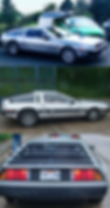
The DeLorean Motor Company was founded in 1975 by John Z. DeLorean, a former General Motors executive known for his bold ideas and rebellious streak. His vision was to create a futuristic, ethical sports car that broke away from Detroit’s conventions.
To fund the venture, DeLorean secured private investments (including from celebrities like Johnny Carson), a dealer-backed investment scheme, and most crucially, £80 million from the British government, which was eager to create jobs in Northern Ireland during the Troubles. This led to the construction of a state-of-the-art factory in Dunmurry, near Belfast.
Production of the stainless steel, gullwing-doored DMC-12 began in 1981, but quality issues, high pricing, and underwhelming performance hurt sales. The company collapsed in 1982, shortly after DeLorean was arrested in a high-profile drug sting (he was later acquitted). Though short-lived, the brand became legendary thanks to its starring role in *Back to the Future*.
Want to explore how the factory operated or how Lotus helped re-engineer the car? There’s plenty more to uncover.

Get The Complete Picture. If you are interested enough to read about classic cars you will be interested in the environment in which they were created.
Check out our Cost of Living pages indicated below to better understand the limitations of the period in which classic cars evolved.
DeLorean (1981-82)
The story of the **DeLorean Motor Company (DMC)** is one of ambition, innovation, and dramatic collapse—an automotive legend forged in stainless steel and sealed by pop culture immortality.
🚗 Origins: A Maverick’s Dream
Founded in **1975** by **John Z. DeLorean**, a charismatic former General Motors executive, the company was born from his desire to build a car that broke the mold—both in design and ethics. DeLorean envisioned a futuristic, safe, and long-lasting sports car that would stand apart from Detroit’s status quo.
To fund this vision, he secured backing from private investors (including Johnny Carson and Sammy Davis Jr.), a dealer investment scheme, and most significantly, **£80 million from the British government**, which was eager to create jobs in **Northern Ireland** during the Troubles.
🏭 The Dunmurry Factory
DMC’s factory was built in **Dunmurry, near Belfast**, and began production in **early 1981**. The facility was state-of-the-art, but the workforce—many of whom had never worked in manufacturing—faced a steep learning curve. Early cars suffered from quality issues, prompting the creation of **Quality Assurance Centers** in the U.S. to rework vehicles before delivery.
🚘 The Car: DMC-12
The company’s only model, the **DeLorean DMC-12**, featured:
- **Brushed stainless steel body panels**
- **Gullwing doors**
- A **rear-mounted PRV V6 engine**
- A chassis re-engineered by **Lotus**
Despite its striking looks, the car was **underpowered and overpriced** (around $25,000—more than a Porsche 911), which hurt sales.
💥 Collapse and Scandal
By late 1981, DMC was in financial trouble. Sales were far below the break-even point, and a planned stock flotation was blocked by the SEC. In a desperate attempt to save the company, John DeLorean became entangled in a **high-profile FBI sting operation** involving drug trafficking. Though he was **acquitted on grounds of entrapment**, the damage was done.
The company declared **bankruptcy in October 1982**, having produced just under **9,000 cars**. The dream was over.
🕰️ Legacy and Revival
Ironically, the DeLorean’s true fame came **after its demise**, when it was immortalized as the **time machine in *Back to the Future*** (1985). In 1995, a new company—**DeLorean Motor Company (Texas)**—was founded by Stephen Wynne, who acquired the original parts inventory and trademark. Today, it services and restores DMC-12s and has teased modern reinterpretations, including the electric **Alpha5**.
The DeLorean story is a rare blend of **engineering ambition, political intrigue, and cultural mythology**.
*****
Global Popularity
Not in its original form—**the DeLorean DMC-12 was not a global commercial success** during its brief production run from 1981 to 1982. While it’s now a cult icon, especially thanks to *Back to the Future*, its real-world sales and market penetration were limited and largely confined to the United States.
🌍 Global Reach: Limited
- **Primary Market**:
- **🇺🇸 United States** accounted for over **75% of total sales**, with approximately **6,681 units** sold.
- **Secondary Markets**:
- **🇬🇧 United Kingdom**: ~300–500 units
- **🇨🇦 Canada**: ~100–200 units
- Other countries (Germany, Japan, Australia): *minimal numbers*, mostly grey imports
Despite being built in **Northern Ireland**, the UK market was never a major focus, and distribution outside North America was sparse.
📉 Why It Fell Short Globally
- **High price**: At ~$25,000, it was more expensive than a Porsche 911 or Corvette.
- **Underwhelming performance**: The PRV V6 engine didn’t match the car’s exotic looks.
- **Build quality issues**: Early production suffered from inconsistent assembly and reliability concerns.
- **Limited dealer network**: Especially outside the U.S., making service and support difficult.
- **Economic headwinds**: A global recession and rising interest rates dampened demand for niche luxury cars.
🕰️ Posthumous Fame
While it failed commercially, the DeLorean’s **cultural afterlife** has been extraordinary. Its role as a time machine in *Back to the Future* gave it global recognition that far exceeded its original sales footprint.
*****

















